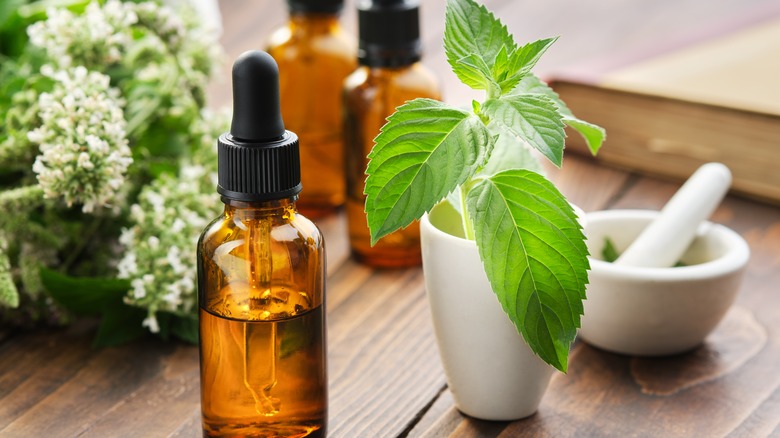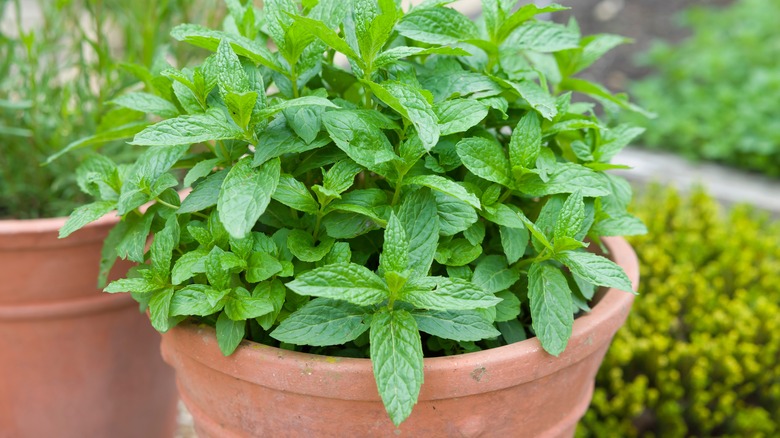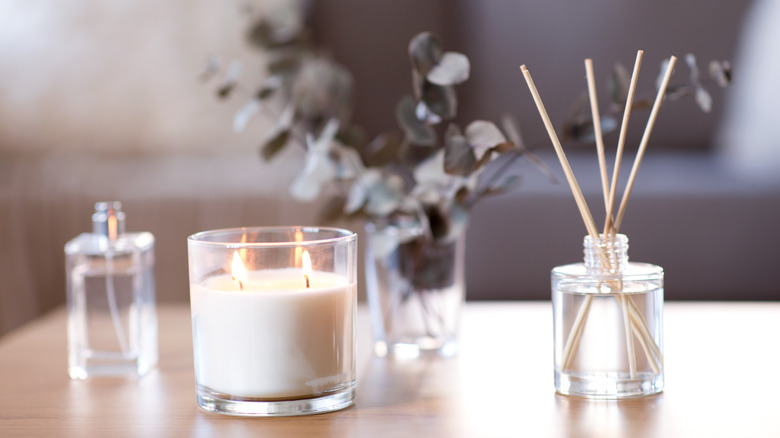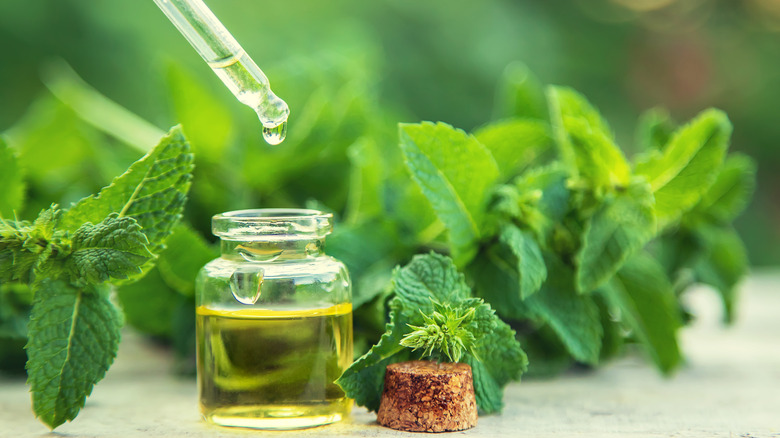Ways You Can Use Peppermint Essential Oil In Your Home
If you ever doubted the power of a scent, all you need to do is think of one with a strong connection to your life. You'll find yourself transported back to the time and place associated with that scent. Childhood might be connected to the mouth-watering aroma of an apple pie baking in the oven, the comforting fragrance of your mother's perfume, or the glee you felt rolling around on a freshly mowed lawn. Summer memories might be associated with the freedom of coconut-scented sunscreen slathered on you and your friends at the lake, or the overpowering acridity of blacktop poured onto a road while you idled in a hot car waiting your turn to pass by (maybe on the way to the lake).
The sense of smell is so powerful, says Psychology Today, that it can alter mood and performance. Peppermint essential oil, they note, has been proven to rev up the body and mind. Incorporating it as a part of a morning wake-up call or late afternoon pick-me-up is just the beginning of how you can use peppermint essential oil in your home. Wayfair shares there are several uses for essential oils, allowing you to get them into the air so that your olfactory senses can sniff out the resulting benefits. And what better place to start than with peppermint's popular and helpful scent and uses?
What is peppermint essential oil?
Despite the recent surge in popularity among essential oils, these substances have been used for millennia. The National Institutes of Health (NIH) notes that peppermint oil, Mentha x piperita, is derived from the leaves and flowering portions of the peppermint plant, which is a cross between two other mints: spearmint, which is a familiar flavor and scent to most people, and watermint. Reluctant Gourmet breaks down the difference in mintiness by describing how the different chemical compounds play in the mouth: Spearmint contains carvone, which provides a cooling effect and sweetness, while peppermint contains a high degree of menthol. Menthol generates peppermint's powerful minty flavor but with a strong spicy, peppery undertone.
According to Healthline, essential oils can be created by a distillation process or by a process known as cold pressing, which results in a product that doesn't last long. Distilled essential oils are preferred over cold-pressed oils, so consumers will want to explore the process used for extracting the oils before investing in them.
Great home and garden uses
Peppermint oil is a multipurpose workhorse substance for your home and garden. The herb's strong, uplifting scent is a welcome addition to most cleaning products, particularly ones you make yourself, but it isn't just the scent that is appealing. Peppermint also has properties that make cleaning your home, keeping pests at bay, or improving your garden a cinch. Smelly drains anywhere in your home can be a struggle for even the neatest homemaker. For instance, some experts recommend using peppermint essential oil and a little baking soda dissolved in boiling water to turn a smelly drain into a thing of the past.
Essential oils often aren't inexpensive (generally due to their concentrated nature), so you may want to try a few frugal tips around the home to get the most bang for your oily buck. Little House Living suggests saturating a cotton ball with peppermint essential oil, which can then be used in several ways: Swipe it along windowsills and door jambs, or pop it into the bottom of garbage cans to keep them from smelling.
In the garden, peppermint isn't just a pretty plant to grow; as we know here at House Digest, it's also useful for going after those pesky aphids and other bugs. The Salt Lake City government offers a sustainable method for deterring insects by using peppermint essential oil mixed with other oils and water in a spray bottle.
Aromatherapy
Peppermint oil is an excellent scent to use for aromatherapy, described as an alternative, complementary, and therapeutic health option. Johns Hopkins notes that incorporating essential oils into an aromatherapy session can be accomplished through the sense of smell or by absorption through the skin, such as during a relaxing foot soak or a massage.
The smell of peppermint offers a multitude of benefits to the brain and mood, according to Johns Hopkins. Its aroma calms nervousness, reduces stress, improves memory, augments awareness, and more. That's a lot of aromatherapy in one sniff! Aromatic medicine in the home can be as easy as lighting a scented candle or setting out a diffuser; products abound to complement your décor and the room location. You could also do a fun craft with the kids and scent your candles with peppermint essential oil or make your own reed diffuser using paper straws, as per Apartment Therapy.
Sometimes aromatherapy is an important part of helping people suffering from a variety of ailments. For example, the Oncology Nurse Advisor reports that a cool cloth infused with a little peppermint essential oil helps decrease nausea. That queasiness solution could be helpful for not just the cancer patients on whom it was tested but also pregnant women suffering from morning sickness, the elderly who might have delicate digestive systems, or children who can't tolerate adult nausea medications.
Medical and topical uses
It's easy to see why peppermint essential oil is used in many homes. WebMD shares that some of its many benefits include antimicrobial and antioxidant properties and therapeutic benefits such as battling headaches or improving gastrointestinal problems. In addition, peppermint essential oil can relieve minor itching caused by bug bites or allergic reactions.
While studies are inconsistent in determining whether peppermint's properties can relieve dandruff, for instance, it does show promise in reducing symptoms related to chronic gut problems, such as irritable bowel syndrome (IBS), according to the Cleveland Clinic.
Furthermore, CreakyJoints includes peppermint essential oil among the oils needed to create an arthritis oil blend that seeks to reduce pain in its users. With 44% free menthol, this substance acts by generating a hot a cold sensation that helps alleviate pain. They state that using a single oil alone can reap some benefits, but combining them can have exponential results.
Cautions when using peppermint essential oil
Peppermint essential oil is a strong and powerful substance and, as such, requires practitioners to exercise care regarding its use. In addition, many essential oils are toxic in varying degrees since they are concentrated forms of the plants they represent.
Essential oils are sometimes listed as food grade, but even if they have that label, Cleveland Clinic cautions users to tread lightly when considering ingesting essential oils. They warn that they could damage mucus linings, the liver, and other bodily systems, adding that pets, too, may be at risk. MedicalNewsToday echoes that warning, adding a reminder that incorporating essential oils into another oil (a carrier oil) helps dilute any substances applied topically.
Despite the warnings issued by some sources, the National Institutes of Health believes that peppermint essential oil is safe to ingest in doses commonly used (though it doesn't define the size or quantity of those doses). However, NIH does note that there can be side effects, including abdominal pain, heartburn, and rashes. They advise consulting with your personal physician for more information. One final note about safety, WebMD asserts that for maximum reliability, individuals should purchase the oils only from vendors who have been FDA-approved.





